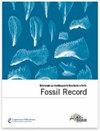下载PDF
{"title":"Trajectories of Late Permian – Jurassic radiolarian extinction rates: no evidence for an end-Triassic mass extinction","authors":"Wolfgang Kiessling, Taniel Danelian","doi":"10.1002/mmng.201000017","DOIUrl":null,"url":null,"abstract":"<p>The hypothesis that ocean acidification was a proximate trigger of the marine end-Triassic mass extinction rests on the assumption that taxa that strongly invest in the secretion of calcium-carbonate skeletons were significantly more affected by the crisis than other taxa. An argument against this hypothesis is the great extinction toll of radiolarians that has been reported from work on local sections. Radiolarians have siliceous tests and thus should be less affected by ocean acidification. We compiled taxonomically vetted occurrences of late Permian and Mesozoic radiolarians and analyzed extinction dynamics of radiolarian genera. Although extinction rates were high at the end of the Triassic, there is no evidence for a mass extinction in radiolarians but rather significantly higher background extinction in the Triassic than in the Jurassic. Although the causes for this decline in background extinction levels remain unclear, the lack of a major evolutionary response to the end-Triassic event, gives support for the hypothesis that ocean acidification was involved in the dramatic extinctions of many calcifying taxa. (© 2011 WILEY-VCH Verlag GmbH & Co. KGaA, Weinheim)</p>","PeriodicalId":55147,"journal":{"name":"Fossil Record","volume":"14 1","pages":"95-101"},"PeriodicalIF":2.1000,"publicationDate":"2011-02-22","publicationTypes":"Journal Article","fieldsOfStudy":null,"isOpenAccess":false,"openAccessPdf":"https://sci-hub-pdf.com/10.1002/mmng.201000017","citationCount":"18","resultStr":null,"platform":"Semanticscholar","paperid":null,"PeriodicalName":"Fossil Record","FirstCategoryId":"89","ListUrlMain":"https://onlinelibrary.wiley.com/doi/10.1002/mmng.201000017","RegionNum":4,"RegionCategory":"地球科学","ArticlePicture":[],"TitleCN":null,"AbstractTextCN":null,"PMCID":null,"EPubDate":"","PubModel":"","JCR":"Q3","JCRName":"Earth and Planetary Sciences","Score":null,"Total":0}
引用次数: 18
引用
批量引用
Abstract
The hypothesis that ocean acidification was a proximate trigger of the marine end-Triassic mass extinction rests on the assumption that taxa that strongly invest in the secretion of calcium-carbonate skeletons were significantly more affected by the crisis than other taxa. An argument against this hypothesis is the great extinction toll of radiolarians that has been reported from work on local sections. Radiolarians have siliceous tests and thus should be less affected by ocean acidification. We compiled taxonomically vetted occurrences of late Permian and Mesozoic radiolarians and analyzed extinction dynamics of radiolarian genera. Although extinction rates were high at the end of the Triassic, there is no evidence for a mass extinction in radiolarians but rather significantly higher background extinction in the Triassic than in the Jurassic. Although the causes for this decline in background extinction levels remain unclear, the lack of a major evolutionary response to the end-Triassic event, gives support for the hypothesis that ocean acidification was involved in the dramatic extinctions of many calcifying taxa. (© 2011 WILEY-VCH Verlag GmbH & Co. KGaA, Weinheim)
晚二叠纪-侏罗纪放射虫灭绝率的轨迹:没有证据表明三叠纪末发生了大规模灭绝
海洋酸化是三叠纪末海洋大灭绝的直接诱因的假设是基于这样的假设,即那些大量分泌碳酸钙骨骼的分类群比其他分类群受到危机的影响更大。反对这一假设的一个论点是,据报道,放射虫在当地部分的灭绝造成了巨大的损失。放射虫有硅质测试,因此受海洋酸化的影响较小。整理了晚二叠世和中生代放射虫的分类分布,分析了放射虫属的灭绝动态。虽然三叠纪末期的灭绝率很高,但没有证据表明放射虫发生了大规模灭绝,但三叠纪的背景灭绝率明显高于侏罗纪。虽然背景灭绝水平下降的原因尚不清楚,但缺乏对三叠纪末事件的主要进化反应,支持了海洋酸化与许多钙化分类群的急剧灭绝有关的假设。(©2011 WILEY-VCH Verlag GmbH &KGaA公司,Weinheim)
本文章由计算机程序翻译,如有差异,请以英文原文为准。

 求助内容:
求助内容: 应助结果提醒方式:
应助结果提醒方式:


